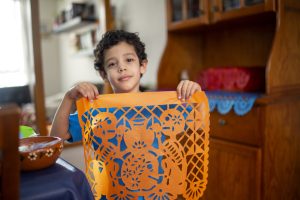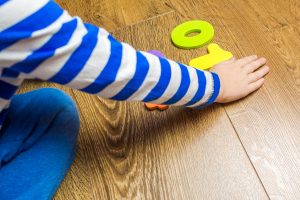- Talking about math promotes the development of children’s math skills.
- Caregivers can look for opportunities to ask children to explain their math thinking.
- Using hand gestures can help children connect what they’re hearing with what they’re seeing.
“Let’s play blocks while we wait for dinner to heat up. How many blocks do you think we’ll need to build a tower as high as the table? That block looks too narrow to hold this big one at the bottom. Which one should we use instead?”
Having conversations about math supports young children’s mathematical learning. During math conversations, children hear words that describe quantities, sizes, shapes, and locations. These math words help them notice the math in everyday life. Participating in math conversations also allows children to practice using math words themselves and to think about math in more complex ways.
Adults can engage children in math conversations by asking questions that promote children’s math learning. There are many opportunities to ask math questions throughout the day, including during meals and snacks, reading, play, and bedtime. Here are some tips for asking questions that make the most of math conversations.
Ask Questions That Deepen Math Thinking
“Look, you used one, two, three green blocks and one, two blue ones. [point to each block as they’re counted.] I like how you put this green block above the blue block. How can we add another one without knocking over the tower?”
Encourage children to use math words. Instead of asking questions that call for a yes or no response, such as “Are there three fish here?” or “Is that a triangle?” ask questions that invite children to respond using math words:
- “How many fish do you see here?”
- “What shape is this? How do you know?
- “Where in line is the bear?”
Catch children’s interest. When children are interested in an activity, it can be more motivating for them to think and talk about math. Ask questions that fit with your child’s interests, follow what your child is already doing, and help your child reach a goal they care about:
- “How can we split up this tray of brownies so everyone in the family gets the same number of brownies?”
- “Who had the most cards at the end of the game?”
- “Look at this castle you built! What shapes do you see in the blocks?”
Focus on the “how” and “why.” Ask questions that encourage children to explain their thinking. This can create opportunities for discussions that deepen children’s math thinking:
- “Why do you think a yellow flower would come next in this pattern?”
- “How do you know we have enough plates for everyone?”
- “Why did you sort these shapes together and this other pile of shapes together?”
Make the Most of Math Conversations
“What shape is this block? How do you know? What do you think will happen if we turn that block this way? [rotate the block]”
It’s OK if your child responds with “I don’t know” or makes a mistake. In these moments, asking a follow-up question and sharing your ideas can promote meaningful exploration of math ideas and keep these conversations joyful. For instance: “How do you know I have more berries? You’re not sure? Well, let’s see. How many do I have, and how many do you have?
Pointing and using gestures can help children make connections between math words they’re hearing and what they’re seeing. For example, gesturing to sets of objects when labeling their quantity helps children connect number words to the quantities they are seeing: “I have six berries [use your hand to circle or underline your berries] and you have four berries [point to their berries]. So, you’re right, I have more because six is more than four [move your hands apart and then closer together to show that their set of berries is smaller].”
Comparing and contrasting by talking about how things are similar or different helps strengthen children’s understanding of math concepts: “See, these are both squares because all four sides are the same length. But this rectangle isn’t a square because these two sides are longer than the other two sides.”
Try having math conversations during daily family routines and play to make math talk a part of your child’s life. By doing this, you’ll help grow your child’s math learning and love of math!



